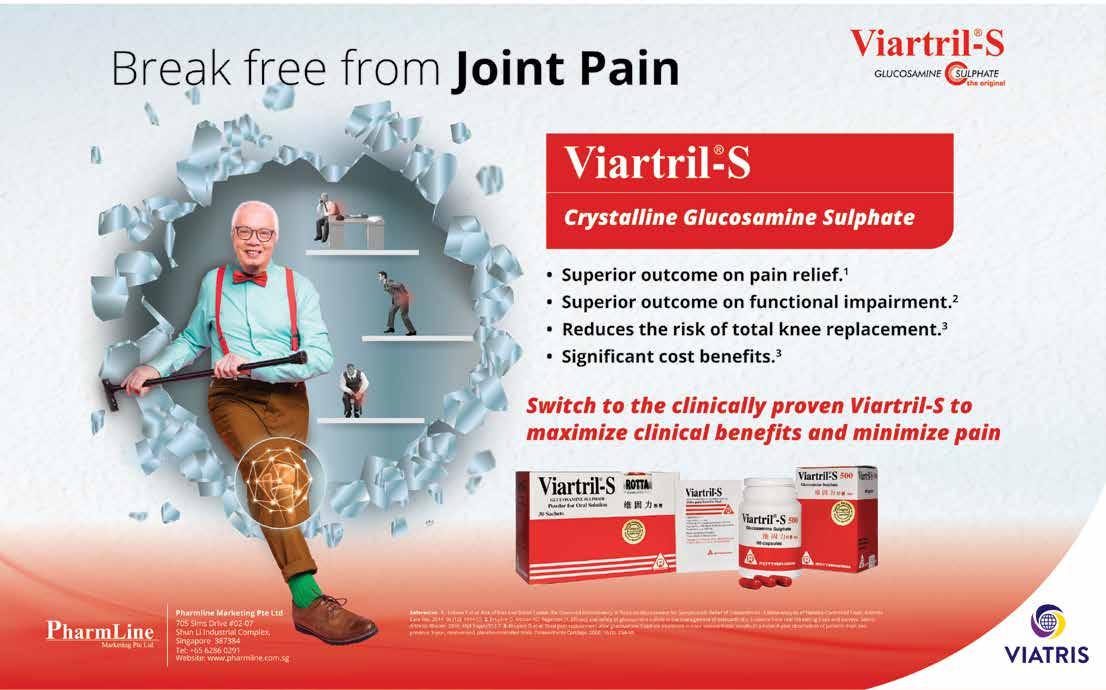
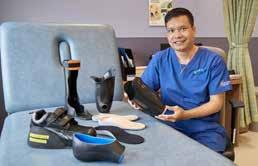
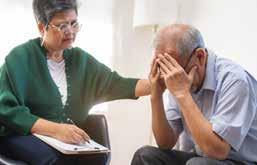

THE FLAGSHIP PUBLICATION OF THE SINGHEALTH DUKE-NUS ACADEMIC MEDICAL CENTRE Jul-Aug 2024 www.sgh.com.sg www.singhealth.com.sg MCI (P) 003/07/2024 Enhance your reading experience! Scan the QR code and let us know what new features you’d like to see. 14 HealthWatch Mental deterioration is evitable with age InFocus New clinic offers amputees quicker turnaround for their artificial limbs 05 BeWellwithSingHealth Making sense of the numerous biomarkers in our blood 12 EGH Campus to run virtual wards The hospital campus will be digitally enabled Read more on page 02


CONTENT ADVISORS
Audrey Lau, Jennifer Wee
EDITORIAL TEAM


Read Singapore Health online at www.singhealth.com. sg/singaporehealth
PUBLISHING AGENT
ThinkFarm Pte Ltd
Managing Director Christopher Tay
Head, Editorial Chua Kim Beng
Head, Creative Lee Lily
Head, Client Relationship Jessie Kek
For advertising enquiries, please call 6831 1299 or email advertise@thinkfarm.sg
Lim Mui Khi, Domenica Tan, Jenny Ang, Celine Sim All rights reserved. Copyright by Singapore Health Services Pte Ltd (registration no.: 200002698Z). Opinions expressed in Singapore Health are solely those of the writers and are not necessarily endorsed by SGH, SingHealth Group and/or Thinkfarm Pte Ltd (registration no.: 201226362G), and their related companies. They are not responsible or liable in any way for the contents of any of the advertisements, articles, photographs or illustrations contained in this publication. Editorial enquiries should be directed to the Editor, Singapore Health 168 Jalan Bukit Merah, #13-01 Surbana One, Singapore 150168, or email: singaporehealth@singhealth.com.sg. Unsolicited material will not be returned unless accompanied by a self-addressed envelope and sufficient return postage. While every reasonable care will be taken by the
New EGH campus’ phygital efficiency hailed as first of its kind
At the official groundbreaking ceremony of the Eastern General and Community Hospitals, Minister for Health, Mr Ong Ye Kung, shared about innovations that combine physical healthcare services with digital technology to better care for patients and the community.
by Timothy Wee
The road towards the development of the Eastern General and Community Hospitals (EGH Campus) reached a major milestone with its groundbreaking ceremony. Officiated by Minister for Health, Mr Ong Ye Kung, the ceremony was held in conjunction with the hospital’s Community Day event and attended by close to 1,000 healthcare professionals, grassroots and community partners, and residents on Saturday, 20 April. The EGH Campus will consist of two hospitals: Eastern General Hospital (EGH) and Eastern Community Hospital
(ECH). EGH will provide emergency, acute and secondary patient care, and specialty clinical services, while ECH will focus on rehabilitative care and offer dedicated palliative and dementia services to patients. EGH intends to start running virtual wards around 2026. The hospital’s healthcare professionals will be nested in SingHealth hospitals such as Changi General Hospital (CGH) as they tap on digital solutions — including real-time remote monitoring, telemedicine and wearable technology — to monitor and communicate with eligible patients recovering at home. This will form the SingHealth@Home mobile
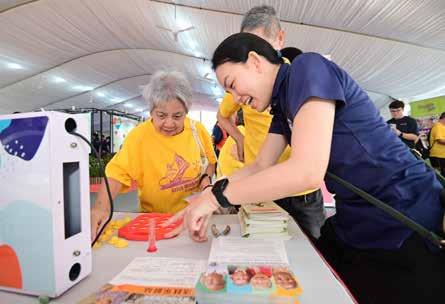
inpatient care programme, to enhance and expand the programme’s capacity. With this, EGH will be the first general hospital to deliver services before the completion of its physical infrastructure.
“EGH represents a good balance between innovation, continuous improvement, and also standardisation for efficiency and quality,” said Mr Ong.

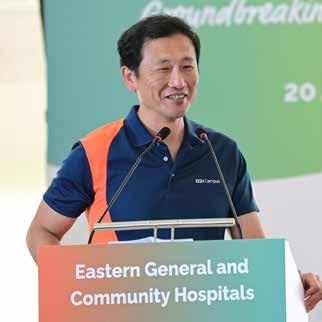
Slated to be completed around 2029–30, the approximately 1,400-bed campus will provide patient-centred care to residents in the east of Singapore.
Outlining EGH’s mission, Professor Lee Chien Earn, Chairman, EGH Hospital Planning Committee, and Deputy Group CEO (Regional Health System), SingHealth, said: “The new Eastern General and Community Hospitals will serve residents who need urgent, acute as well as continuing medical care. We are also working with our community partners to make the Campus a hospital without walls, where we help residents who are ready for community-based care complete their
Eastern General Hospital represents a good balance between innovation, continuous improvement, and also standardisation for efficiency and quality.
Mr Ong Ye Kung Minister for Health
recovery journey in the comfort of their homes with their loved ones, neighbours and friends close by. Additionally, through close collaborations with our primary care and community partners, we aim to help residents in the east proactively take charge of and regain their health so that they can live long and well.”
Human touch in digitally enabled hospital campus
To fulfil this mission, EGH Campus will be digitally enabled, with IT infrastructure designed and incorporated from the outset, and trained staff to deliver telemedicine.
For example, ECH aims to harness smart technology such as wearable sensors and AI-assisted applications for patients to continue with their rehabilitation exercise post-discharge, enabling physiotherapists to customise exercise programmes for patients, and remotely monitor and track patients’ recovery progress while they await for their community rehabilitation to commence. While technology will help streamline processes and augment patient care, the human touch remains crucial for personalised care and fostering meaningful connections. Care teams will familiarise patients with the devices during their hospital stay so that they will feel confident to use it back home.
02 CoverStory 03
PRINTING. MCI (P) 003/07/2024. Printed in Singapore by Times Printers Pte Ltd (registration no.: 196700328H).
Editor, no responsibility is assumed for the return of unsolicited material. ALL INFORMATION CORRECT AT TIME OF
CO-PUBLISHERS ® PUBLISHERS
Artist’s impression of the various areas of the Campus, such as the view of the Campus from the road junction (left), the Rehab Garden (above) and the Green Promenade (below).
EGH and ECH will also continue to work closely with partners in the region as an integrated approach to empower patients to get well and live well in the community.
For example, ECH will collectively work with partners to deliver seamless care transitions for patients from hospital to home, enabled by SingHealth Community Hospitals’ social prescribing programme that connects patients with community assets to support their overall well-being.
The ‘One SingHealth’ approach
Despite being the newest hospital campus in the cluster, Prof Lee said that its “workforce draws expertise from hospitals and speciality centres within SingHealth”. Calling it the ‘One SingHealth’ approach, Prof Lee shared that the EGH Campus will tap on SingHealth healthcare professionals’ wealth of experience in the planning, design and delivery of patient care.

Scan the QR code to view a video about the future EGH Campus.

Prof Lee Chien Earn says that the EGH Campus workforce will draw expertise from hospitals and speciality centres within SingHealth, an initiative he refers to as the ‘One SingHealth’ approach.
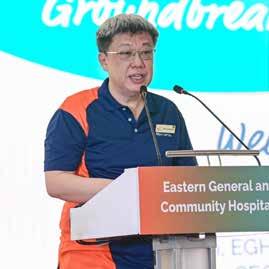


The
most useful health app for all your needs!

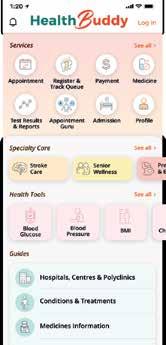






APPOINTMENT
View and reschedule your appointments with ease!
PAYMENT
Pay anywhere, after consultation or treatment.
ORDER MEDICINE
Arrange for FREE delivery of your medicines!
TEST RESULTS & REPORTS
See all your test results here!
HEALTH TOOLS
Track your blood glucose, blood pressure, weight and more!
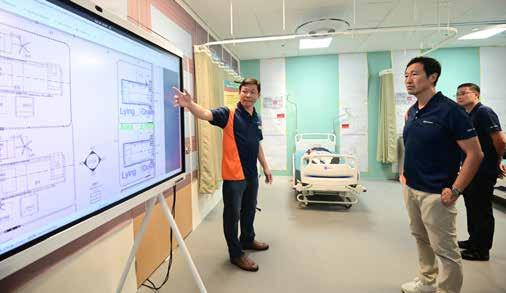
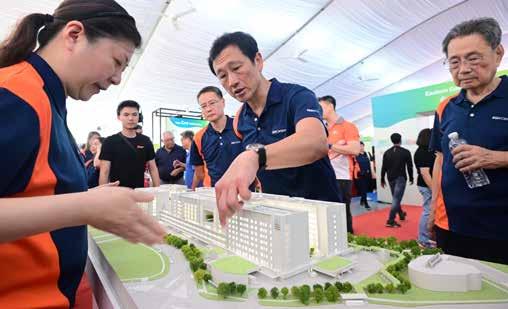
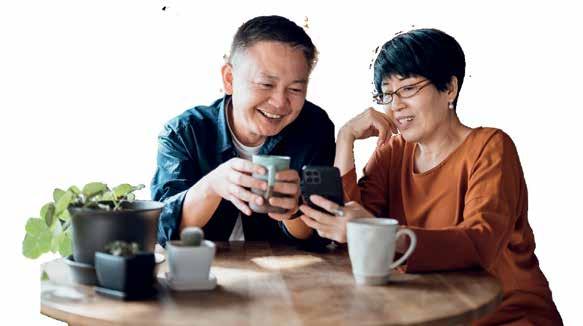
04 CoverStory
Minister Ong at the EGH Campus groundbreaking event, where he visited the Healthcare Living Laboratory and took a look at the Campus’ developmental blueprint.
Stepping into new legs in no time
A
new method of making artificial limbs at SGH’s Prosthetics and Orthotics clinic ensures prompt rehab for amputee patients.
by Candice Cai
For patients who have had a lower limb amputated, using a well-fitting prosthesis as soon as possible helps them start rehabilitation faster.
At Singapore General Hospital’s (SGH) Prosthesis and Orthotics (P&O) clinic and workshop, patients can get fitted with an artificial device on the same day under a new method of fabricating and fitting artificial limbs. Thus, rehabilitation and mobility are not delayed.
The Direct Socket Below the Knee Amputation method takes just a couple of hours to cast, fabricate, assemble and fit a prosthesis on to a patient. “This is very convenient for the patient, who can get the prosthesis on the same day.
If no adjustments to the device are needed, the patient can start working with a physiotherapist on walking and other mobility skills,” said Mr Saros Rouen, Principal Prosthetist and Orthotist (Management), Podiatry Department, SGH.
SGH is the first in Southeast Asia to introduce this method of fabricating a prosthesis for below-knee amputations. This is no small feat considering that the hospital only started its own workshop in early 2023. Before, manufacturing and assembly of prostheses for its patients was supported by Tan Tock Seng Hospital (TTSH). With its own P&O workshop, SGH is now able to better support patients
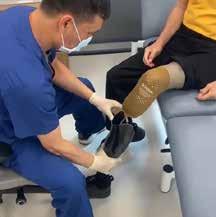

“We aim to be a forerunner in cuttingedge prosthetics fitting and fabrication technology for better patient care, such as in assistive robotics and 3-D printing,” says Mr Saros Rouen, fitting a prosthesis onto a patient’s leg (left).
Patients of the workshop are able to get their prostheses within a few hours instead of as long as a month.
Making a direct below-knee amputation socket
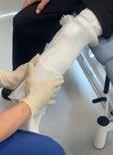
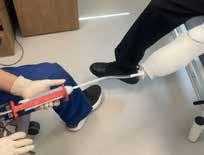
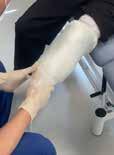
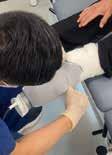
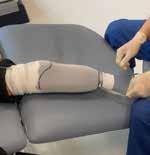
Prostheses made using the Direct Socket Below the Knee Amputation method are lighter, stronger, more comfortable, and easier to use than those made traditionally. Moreover, patients are able to get their prostheses within a few hours instead of as long as a month.
This is because the fabrication of the prosthesis or socket under the new method is done directly on the patient using glass fibre, resin and a hardener, said Mr Saros Roeun, Principal Prosthetist and Orthotist, SGH. “The glass fibre and resin are bound together during the process, giving a strong and durable prosthesis with an increased range of motion and a snug socket fit.”
In making a socket to fit over a patient’s stump, Mr Rouen first makes an assessment to check the patient’s muscle power, joint function, and sensitive areas on the stump. Making of the socket mould (above, from left) involves adding layers of materials — a casting liner first, then an insulator, glass fibre, then another insulator — before the resin, that includes a hardening agent, is injected into it. The mould is then left to harden for about 10 minutes. The moulded socket, removed from the leg, is ready for cutting and smoothing. The prosthesis is ready to be fitted and worn within 90 minutes, compared to the traditional method where, after casting, the component is ordered for delivery a couple of weeks later.
The much shorter turnaround time allows more patients to be seen. More importantly, patients can move on to rehabilitation more quickly, said Mr Roeun. The workshop does not take up much space as large or complex machines, such as those required for the traditional manufacturing of prostheses, are not needed.
through a full range of services, including the manufacturing of both prostheses and orthoses, said Mr Rouen.
Prostheses are custom-made devices that fit over missing limbs, while orthoses help support patients with muscle weakness or joint instabilities through the use of knee ankle foot orthoses, ankle foot orthoses, and insoles and modified shoes for common ailments like flat feet. “We aim to be a forerunner in cutting-edge prosthetics fitting and fabrication technology for better patient care, such as in assistive robotics and 3-D printing,” said Mr Rouen.
With the introduction of its Direct Socket Below the Knee Amputations method, the service has substantially reduced the time taken to receive prostheses. Under the traditional method, which involves the full process from casting to fitting, it takes as long as a month before a patient is able to start walking with a prosthesis.
The P&O clinic works in tandem with pre-operative rehabilitation medicine specialists, physiotherapists, prosthetists and orthotists, and social workers to provide a holistic care path for patients. Besides providing prosthetic and orthotic services to patients in SGH, it also supports patients in other SingHealth hospitals — Sengkang General and Changi General Hospitals.
Amputations can be due to accidents or complications from diseases or infections. Mr Saros reckoned that nine in ten of the SGH patients that he fits for prostheses are for diabetes-related complications. “We pride ourselves on providing fast access to postamputation care to allow patients to start rehabilitation quicker and provide a good quality of life after surgery,” he added.
05 InFocus
PHOTOS: VERNON WONG
Music to help patients undergoing C-section
A music-based intervention programme proves to be effective in lowering anxiety and pain magnification among patients undergoing Caesarean section surgery.
by Timothy Wee
Music can set the mood in a room to alter one’s state of mind.
There is no doubt that music has its benefits, but is it relevant in a medical setting? According to patients who participated in KK Women’s and Children’s Hospital (KKH)’s music-based intervention programme, Healing Tunes, the answer is a resounding “yes”.
A soundtrack for giving birth Launched last May, and the first of its kind in Singapore, Healing Tunes allows patients undergoing Caesarean section to select songs and create a playlist to accompany their experience. By listening to their music selection before, during and after the surgery, the programme aims to reduce anxiety and pain magnification.
Associate Professor Sng Ban Leong, Head and Senior Consultant, Department of Women’s Anaesthesia, KKH, and his team found in a study that, with musicbased intervention, their patients’ state of mind improved significantly. “In the study published in 2023, among the group of patients who had the music-based intervention when undergoing elective Caesarean sections, their anxiety scores were halved, and pain magnification scores were reduced by 35 per cent,” said Assoc Prof Sng. The research paper on that study, ‘Effect of music listening on perioperative anxiety, acute pain and pain catastrophising in women undergoing elective Caesarean delivery’, was published in BMC Anaesthesiology
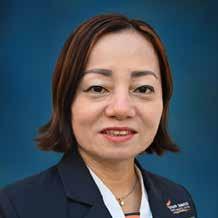
Under the Healing Tunes programme, patients undergoing Caesarian section listen to music of their choice, which “can be effective in reducing anxiety, which in turn can make the Caesarian surgery experience less daunting”, says Ms Kayla Wong.
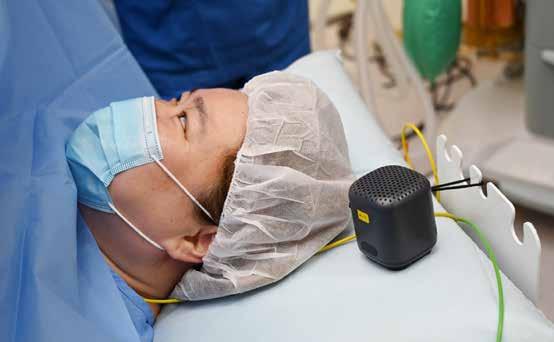
Ms Kayla Wong, Senior Music Therapist, Child Life, Art and Music Therapy Programmes, KKH, explained that patients listening to their preferred music enjoy “the effect of increasing relaxation, bringing on the associated benefit of alleviating anxiety”. She added: “Evidence shows that music-based interventions can be effective in reducing anxiety, which in turn can make the Caesarean surgery experience less daunting.”
Pregnant with worry
Typically, pregnant patients are given spinal anaesthesia during Caesarean sections but remain awake throughout. As such, they feel anxious and may focus on the pain. Increased blood pressure, heart and breathing rates are the physical effects of anxiety that add to the stress on a patient’s body during surgery
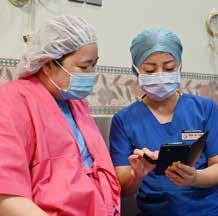
(Below, left to right)
Ms Shen Haiying, Assoc Prof Sng Ban Leong, and Ms Kayla Wong.
Besides having higher pain scores, the effects of anxiety extend beyond surgery, with patients developing an increased risk of persistent pain and postnatal depression. “In the study, which involved 108 KKH patients, we found that anxiety was prevalent in seven out of 10 patients, while pain magnification was prevalent in around three out of 10 patients,” shared Assoc Prof Sng.
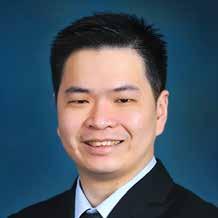

Conventionally, medications are used to treat anxiety related to surgery. But such medications carry side effects that are transferred from the pregnant patient to her baby. Such risks do not apply with Healing Tunes.
Goodbye anxiety
Besides easing the anxiety levels of pregnant patients undergoing Caesarean sections, Healing Tunes offers other benefits. “Our memories are embedded within music that is meaningful to us. Choosing familiar and personalised favourite music to accompany their delivery experience can create stronger familial bonds between parents and the baby,” said Ms Wong.
By curating their delivery experience soundtrack, patients “play a part in their care while sharing a part of who they are through their musical identity with the team”, added Ms Wong. This in turn enables patients to create meaningful connections with the medical staff, allowing them to offer better support. Since the nurses in the Operating Theatres led its implementation, Healing Tunes has enjoyed a high adoption rate among all pregnant patients undergoing Caesarean sections, with almost all opting for the music-based intervention programme. Reactions from the patients have been overwhelmingly positive. Ms Shen Haiying, Senior Nurse Manager, Operating Theatres, KKH, pointed out: “From the feedback that we have gathered, the satisfaction and recommendation rates were 92 per cent and 93 per cent respectively.”
Since late 2023, patients undergoing embryo transfer at the KKIVF Centre have been able to adopt music-based intervention to reduce their anxiety. “The KKH team continues to improve the Healing Tunes workflow and patient satisfaction, and plans to offer it to other types of patients,” shared Ms Shen.
06 InFocus
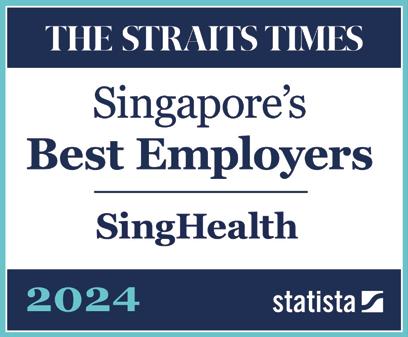


Making sure hospital is well supplied
Automation helps SGH’s materials management department to handle supplies more efficiently, and to gear up for greater demand in the coming years.

Awarehouse is not something that springs to mind when one thinks of Singapore General Hospital (SGH).
But hidden underground in the SGH Campus is a 2,000m2 repository that holds over 1,000 essential items that keeps the hospital’s operations running smoothly round the clock.
Imagine running out of bandages, masks, syringes, surgical gloves, or alcohol wipes.
SGH has some 2,000 beds, with patients requiring single-use dressings, syringes and other consumables for their care and treatment in a safe and clean environment.
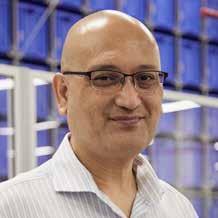
“The hospital warehouse currently handles more than 100 orders a day from wards and other parts of the hospital,” says Mr Rosli Boedjang.

To watch the Instagram
of the warehouse, scan the QR code.
“The hospital warehouse currently handles more than 100 orders a day from wards and other parts of the hospital,” said Mr Rosli Boedjang, Assistant Director, ALPS-SGH NonPharmaceutical Supply Chain Department, SGH.
Since the materials management department moved to its new premises in SingHealth Tower in August 2020, it has automated many of its processes, including the tedious work of picking items ordered. Doing so has made the filling of orders faster and more accurate.
At the same time, said Mr Rosli, this will allow the department to manage up to 250 orders a day in the future as demand for hospital care expands in coming years.
“Automation helps us manage small pickable items, which constitute about 70 per cent of our line items. We pick 30,000 line items a month on average,” Mr Rosli stated.
Giving an idea of the time saved, Mr Rosli said that completing three orders in 45–60 minutes now by one person might have taken three people three hours each to fill the same orders — to look for the items, pick them, then pack them for delivery.
The department became a part of ALPS, the national supply chain company supporting the country’s three healthcare clusters. ALPS procures much of the bulk of medical supplies and drugs that public hospitals commonly need, helping them to enjoy economies of scale. These commonly
The system automatically fills orders by picking items from the shelves (below), conveys them to the packing station (above) for checking and packing for delivery to the wards and SGH departments.
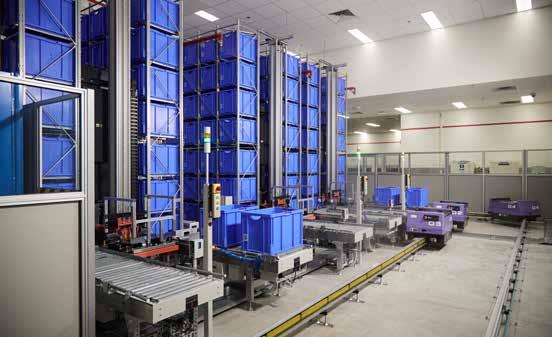


Large items are picked manually from a separate area of the warehouse. Manned trolleys and automated guided vehicles deliver the supplies through a network of tunnels to their destinations at the main SGH complex.
used items are stored in ALPS warehouses, while those that are used specifically by SGH and other hospitals are held by the institutions themselves.
Although the department works fairly regular office hours, orders from the wards can come in at any time via email. Once filled, the orders are put into containers to be carried or hauled by a fleet of automated guided vehicles or manned trolleys through a network of underground tunnels to their destinations at the main
hospital complex and national centres on the SGH Campus.
The department serves mainly SGH but is able to supply the other SingHealth institutions both on and off Campus when needed. The department sits alongside the hospital’s other operational facilities — the kitchens that prepare meals for patients, the linen supplies unit that manages medical scrubs and staff uniforms, inpatient gowns, towels and bed linen, and the sterile supplies unit, which processes surgical instruments.
08 InFocus
PHOTOS: VERNON WONG
video
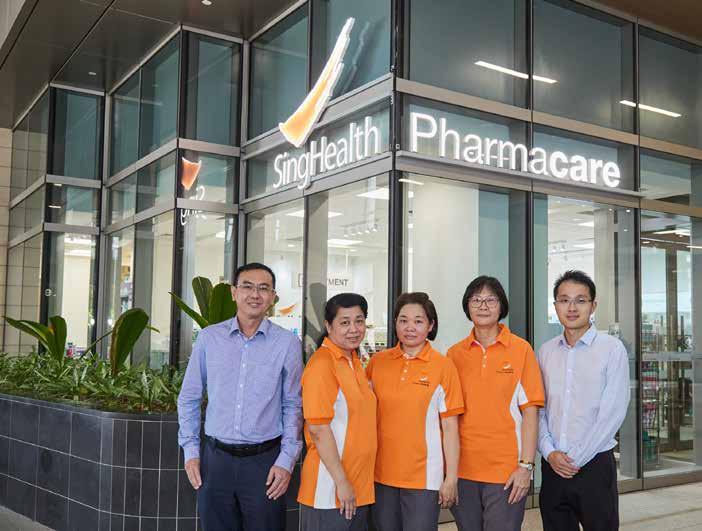
All you need in store and at your fingertips
Retail pharmacy group ensures consistent quality and price.
by Sol E Solomon
In the past, SingHealth’s retail pharmacies were individually managed by the respective institutions they were located in, causing inconsistencies in product ranges and prices in different outlets.
In 2017, SingHealth Pharmacare was established to consolidate the retail pharmacies across SingHealth institutions. Bringing together multiple pharmacies under a unified brand, SingHealth Pharmacare is now responsible for standardised operations and customer care throughout its stores. From its inaugural outlet at SingHealth Polyclinic in Bedok, it has expanded to 12 retail outlets and two e-commerce platforms.
All new products introduced into Pharmacare will be evaluated by the team comprising staff from the Operations, Purchasing, Marketing and Merchandise departments, said Ms Eileen Loh, Merchandise Lead, Pharmacare, who oversees the selection process. “Each product is closely evaluated based on the needs of patients, price competitiveness, market trend, and doctor’s recommendation,” she said. “While the majority of Pharmacare retail products are available across all outlets, there are certain specialised or specific-need products that are only available at outlets affiliated with relevant institutions.”
“For specialists clinics and hospitals like the National Cancer Centre Singapore (NCCS) and the Singapore General Hospital (SGH) Sleep Clinic, there are specific
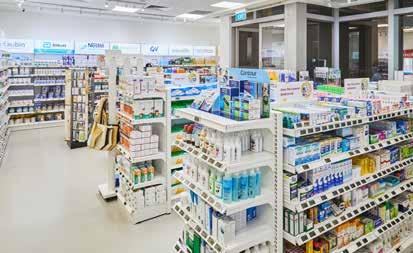
products to address the needs of different patient demographics,” said Mr Leo Choo, Senior Executive, Pharmacare. For example, the NCCS outlet stocks a specialised bra suitable for patients with breast cancer. Customers can schedule appointments with product advisors at the NCCS outlet should they prefer more personalised and discreet assistance. This saves them the potential embarrassment of discussing their condition with staff at other retail establishments. Non-NCCS patients can also buy them at the outlet at the same price.
Another product specific to a selected Pharmacare outlet is the Continuous Positive Airway Pressure (CPAP) machine. Following feedback from the SGH Sleep Clinic, which highlighted to Pharmacare the need for a particular CPAP machine, Pharmacare liaised with various suppliers and manufacturers to identify the most suitable

Scan the QR code to watch an Instagram video of what you can buy at Pharmacare!
Ms Ng Mui Lee and Ms Julie Tang Peck Lan, and Mr Leo Choo.
Available online
When the COVID-19 pandemic arrived, patients faced challenges accessing healthcare products due to restrictions entering healthcare facilities. In 2021, Pharmacare launched products for sale online through Lazada, where patients receive the items via home delivery, thus reducing potential exposure to the virus.
Concurrently, Pharmacare also worked on its own e-commerce platform, which launched in 2023, to offer additional rewards and benefits for patients and staff.
SingHealth Pharmacare Online (www.pharmacaresinghealth.sg) offers a wider range of products, including exclusive products and members’ benefits.
Beyond healthcare products, it also has a selection of lifestyle products such as bath soap, sunscreen sunglasses, trendy tote bags, and healthy snacks and supplements.

machine that met the stringent standards for quality, reliability and affordability. Now, when a patient receives a prescription for a CPAP machine from the SGH Sleep Clinic, doctors can simply direct them to the SGH store. This eliminates the need for patients to navigate the complexities of sourcing their own CPAP machine.
Furthermore, Pharmacare offers Pioneer and Merdeka Generation discounts instore to eligible customers, said Mr Kelvin Loo, Operations Manager, Pharmacare. “SingHealth patients can also enjoy subsidised prices for selected items instore by producing an appointment card or appointment SMS.”
09 InFocus
PHOTOS: VERNON WONG
From left to right: Mr Kelvin Loo, retail assistants Ms Hum Siew Chen,
An atomic love story
Physicist Mr S Somanesan took the nuclear option to harness the science of radiation to save lives. Radionuclides added to drugs can be used to diagnose and treat some cancers and other illnesses.
by Michelle Scully
At 5.30am every day, Singapore General Hospital (SGH) Senior Principal Medical Physicist Mr S Somanesan dutifully checks in on one of his ‘children’ — the hulking, silent 20-year-old giant cyclotron.

to ensure that only the optimal dosage of radiation is administered to patients.’’
A massive machine that manufactures radionuclides, or radioactive materials, for use in pharmaceuticals to diagnose some cancers and other illnesses, the cyclotron holds a special place in Mr Somanesan’s heart. He had singlehandedly managed the procurement of the machine to make SGH the first medical cyclotron facility in Singapore and Southeast Asia in 2003.
Even with an honour’s degree in physics from the National University of Singapore (NUS), he had no idea what radiation physicist or medical physics — the job he applied for in 1989 — was as the discipline was so new and rare. Today, Mr Somanesan leads a team at the Department of Nuclear Medicine and Molecular Imaging, and at the Division of Radiological Sciences, looking after safety and quality management of the hospital’s radiation-related equipment. Hence, the daily check on the cyclotron.
“It was a steep learning curve. I had to learn from the doctors, engineers, nurses and radiographers. Also, there wasn’t the Internet at the time, so I learnt a lot from books and journals,” said Mr Somanesan. “The beauty of my profession is that I see the clinical application of physics I learnt back in university as well as through continual education. It’s so fulfilling to see how the science of gamma rays and x-rays are utilised in the healthcare sector to diagnose and even save lives. This field is never static. It is always evolving with new discoveries and applications. This keeps me excited.”
Mr Somanesan has been the SGH Radiation Safety Officer since 1999, and oversees radiation safety in laboratories, radiology services, research units, animal facilities, and nuclear medicine services on SGH Campus, as well as emergency planning for radiological incidents and accidents. Medical physicists, he said, develop procedures to ensure the safe and effective use of radiation in medicine. “As we harness radiation, we are also mindful of its ill effects. So, we work closely with the doctors and radiographers
That safety aspect extends to staff, including couriers, nurses and healthcare attendants who come into contact with radioactivity to ensure their radiation exposure is kept to a minimum. Radiographers have to carry a TLD (thermoluminescent dosimeter), which measures the amount of radiation they are exposed to at all times.
Teaching and training prospective medical physicists have also been an important part of his job from the start. That has evolved to include evening classes at the Singapore Institute of Technology (where he was appointed as an Adjunct Associate Professor), Nanyang Technological University (NTU), and NUS. Clearly passionate about his work and the field of physics, Mr Somanesan said: “I find joy in making the physics come alive, to make the textbook come alive, to explain to them so that they can understand it better after I explain to them. The teaching component gives me the most pleasure — whether I’m teaching the nuclear med residents, radiology residents, or the student radiographers. I don’t say ‘no’ to work.”
Medical physics is no longer the exotic field that Mr Somanesan first stumbled upon. “It’s now taught at even ‘O’ levels through to university. At NTU, students can do a module on medical physics, where students learn about proton therapy, nuclear medicine, ultrasound and MRI (magnetic resonance imaging),” he said.
The years of learning and practice have earned Mr Somanesan recognition as an expert by the International Atomic Energy Agency (IAEA). Indeed, his humble demeanour hides the reputation he has acquired in the field. A colleague realised that just about everyone at an IAEA course in Sydney, Australia, knew him well. Impressed, she told him that he was a superstar, to which Mr Somanesan replied: “I’ve been around the block. I’m a very old man.”
To find out more about PET and CT scans, scan the QR code to watch a LinkedIn video.

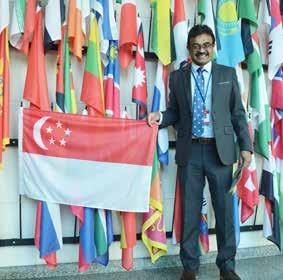
Mr Somanesan standing by the flag post area at the Vienna International Centre during a consultancy expert meeting organised by the IAEA in October 2023.
Somanesan (against the partly seen huge white cyclotron) was instrumental in procuring Southeast Asia’s first cyclotron in 2003 to manufacture radionuclides for use in pharmaceuticals.
It’s so fulfilling to see how the science of gamma rays and x-rays is utilised in the healthcare sector to diagnose and even save lives.

Mr Somanesan (checking on the cyclotron) wears a thermoluminescent dosimeter or TLD (the small black device) to ensure the amount of radiation he is exposed to does not exceed safe levels.

10 People
PHOTOS: VERNON WONG
Mr S Somanesan
Senior Principal Medical Physicist, Singapore General Hospital
Giving joint injuries a sporting chance of recovery
SGH orthopaedic surgeon Dr Chia Zi Yang says every patient is unique so a one-size-fits-all treatment cannot be used for everyone.
by Timothy Wee
When his dog had a dislocated hip, Singapore General Hospital (SGH) orthopaedic surgeon
Dr Chia Zi Yang decided to treat it himself instead of having it undergo surgery to excise the hip. Using orthopaedic principles, he applied traction to ease Sumo’s hip back into the socket.
The creativity in applying his medical knowledge and skills to treat his pet extends to his work on the group of adults who see him for largely sports-related injuries.
As Singaporeans take a greater interest in physical activity, some of which can be strenuous, they are also finding themselves with knee and other joint injuries. Bad knees, for instance, used to be an age-related problem, but his patients are increasingly “youngish middle-agers”, he said.
“Our patients come in with different profiles and enjoy different levels of activity. There are many kinds of requirements so treatment is tailored to each person,” said Dr Chia, Consultant, Department of Orthopaedic Surgery, SGH. “When the patient comes to hospital for treatment, he doesn’t want to feel he’s entering a factory. He appreciates having the doctor understand his problems and then customise a medical solution to his problem. With a wide array of treatments, picking the right one or a combination can help the patient reach a good outcome and keep the knee that he was born with.”
Dr Chia specialises in osteotomy knee preservation, and underwent fellowships at the US’s University of Pittsburgh Medical Center and France’s Assistance Publique Hopitaux de Marseille to further hone his skills in sports medicine. He focused on the soft tissue and bony components of the knee at the US and French centres respectively.
For joints like the knee to work properly, having a stable foundation — the bony structure of the joint — is needed, Dr Chia said. “So my time in Marseille was spent learning how to spot the bony problems and bony solutions, how to have a balanced platform on which the soft tissues can then be added on and corrected accordingly,” he added.
He likens joints to a car where if all the weight is placed on one side, the wheels on that side would get worn

out more quickly. Similarly, when walking, a bow-legged person places pressure on one side of the knees, wearing out that side more over time. The surgeon’s job would then be looking at balancing the joints through surgery or other treatments.
The practice of sports medicine is different from those overseas centres. In Pittsburgh, the sports medicine team looked after professional athletes who had their own medical teams comprising surgeons and therapists, not unlike Formula 1 car racing with their teams of state-of-the-art mechanics. Dr Chia hopes to bring this team-based emphasis on peri-operative care into the treatment of orthopaedic patients in Singapore.

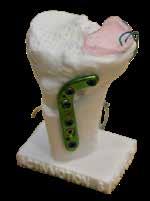
During his fellowship training, Dr Chia also learnt about the US and French health systems as well as their cultures and lifestyles. “In Marseille, people go hiking in the mountains on the weekends. But in Singapore, we tend to hike in the next best thing with air-conditioning — our malls,” he said. He noted, though, that the healthier
Our patients come in with different profiles and enjoy different levels of activity. There are many kinds of requirements so treatment is tailored to each person.
Dr Chia Zi Yang Consultant, Department of Orthopaedic Surgery,
Singapore General Hospital
lifestyle is starting to be replicated, with more Singaporeans exercising more and adopting more sports-related hobbies like cycling.
As more patients seek treatment earlier, many are not ready for a joint replacement. Instead, they look to knee preservation options in this dynamic and innovative field.
Dr Chia sees his role as helping patients pick the best a la carte option.
Dr Chia also works on developmental projects for which he has won $700,000 in grants. One is an implantable spacer device for patients with early knee arthritis. Still in its developmental phase, the device uses a principle similar to the padded cushion in Nike Air sneakers — except that his device is in the knee rather than the shoe.
11 People
PHOTO: VERNON WONG
Dr Chia Zi Yang (below, with his Samoyed, Sumo) is developing a padded device to cushion the joints of the knee (the pink gel-like pad on top of the glass model, above and left).

Biomarker
Creatinine is a waste product from normal muscle breakdown.
Estimated glomerular filtration rate (eGFR) is calculated from the creatinine test result and is an estimate of kidney function.
Electrolytes are minerals, notably sodium and potassium.
Making sense of blood tests
Our blood contains much more than just red blood cells. There are many other biomarkers of health. What are these biomarkers, and what do their presence or lack of mean? by Sol E Solomon
Our blood contains information about the state of our health. Blood tests can indicate how well various organs are working. These tests measure biomarkers that may indicate underlying diseases.
“Renal and liver panels, and full blood count tests are common blood tests to assess overall organ function and detect any potential underlying illnesses,” says Dr Michelle Ee (left). Dr Andrew Wong (right) adds that such tests should not be interpreted without a proper clinical assessment of the patient.
Biomarkers associated with one organ are read together — known as a panel — to ensure a consistent assessment of the health of that organ.

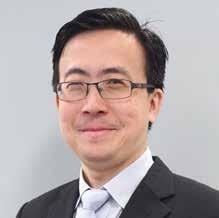
“Renal and liver panels, and full blood count (FBC) tests are common blood tests to assess overall organ function and detect any potential underlying illnesses. For patients with diabetes or hypertension, a renal panel is done on a regular basis,” said Dr Michelle Ee, Associate Consultant, Department of Family Medicine and Continuing Care (FMCC), Singapore General Hospital (SGH). “They can also be monitored following the mediumto long-term use of certain medications such as antibiotics and chemotherapy."
Such tests, however, should not be interpreted without a proper clinical assessment of the patient through history taking
and physical examination, said Dr Andrew Wong, Consultant, Department of FMCC, SGH. "The readings from a renal or liver panel, together with the patient's risks and signs or symptoms, give an indication of whether kidney or liver disease is present respectively. Abnormal individual test results within a panel can be due to causes other than diseases of the specific organ. Paradoxically, normal results may show in patients with serious liver disease, for instance,” Dr Wong added. Patients suffering from high blood pressure, diabetes or with a family history of kidney disease are usually asked to undergo a renal panel as they are at risk of kidney disease; likewise patients who show symptoms that suggest they have a condition affecting the function of their kidneys, such as urine that is foamy, bloody or coffeecoloured. Similarly, a liver panel is ordered when there are signs and symptoms that suggest a liver condition such as jaundice, dark urine, and light-coloured stools.
RENAL PANEL evaluates kidney function
Normal Range
Men: 0.74–1.35mg/dL
Women: 0.59–1.04mg/dL
Comments Abnormal Range
Raised creatinine levels suggest kidney impairment.
>60mL/min <60mL/min suggests kidney impairment; early treatment can help delay or stop kidney disease.
136–144mmol/L High or low sodium levels suggest dehydration or fluid overload.
3.6–5.0mmol/L High or low potassium levels may result in abnormal heart rhythms or muscle weakness.
3.5–5.5g/dL Low albumin levels suggest
Diabetes and hypertension are common causes of kidney impairment. Good control of these conditions may prevent and slow down the progression of kidney impairment.
Table salt is a source of sodium. The recommended daily intake is 2,000mg of salt, or about one teaspoon for healthy adults.
raise potassium levels.
(eg antibodies).
Alanine Transaminase (ALT)
Enzymes facilitate biochemical reactions. The body has thousands of enzymes that perform important functions. 4–36U/L High ALT suggests injury to the liver cells. May be caused by medication, alcohol, infections, poor dietary or exercise habits.
Alkaline Phosphatase (ALP) 30–120U/L High ALP suggests either damage to the liver or bile ducts, or bone disorders
Aspartate Aminotransferase (AST) 8–33U/L High AST suggests injury to the liver or muscle cells. May be caused by medication, alcohol, infections, poor dietary or exercise habits.
Gamma-glutamyl Transferase (GGT)
Platelets help the blood to clot when vessels are damaged.
White blood cells (WBC) protect the body against infection and boost immunity.
Men: 14.0–16.0g/dL
Women: 11.5–14.0g/dL
High GGT suggests damage to the liver, bile ducts. May be caused by alcohol.
Low haemoglobin levels suggest anaemia, where the body cannot carry enough oxygen. May occur when there is abnormal bleeding, the diet lacks certain nutrients (iron, vitamin B12 and folate), or when one has a blood condition called thalassemia.
High haemoglobin levels suggest that the blood is too thick.
140,000–400,000 cells/μL Low platelet levels can cause easy bruising and excessive bleeding.
High platelet levels can cause abnormal clotting.
4,000–10,000 cells/μL Suggests infection, inflammation, diseases of the immune system, or bone marrow disorder
Low readings: Eating food rich in iron, B12, folate may help; doctors may prescribe medication.
High readings: Doctors may prescribe medication, or perform phlebotomy, where excess haemoglobin is drawn out in a process similar to blood donation.
In some instances, further investigations may be needed.
IHEALTHIERSG n support of 12 BeWellwithSingHealth 13
Sodium
Potassium-rich food like banana can
Potassium
malnutrition, liver
kidney
3–8g/dL Low total protein levels suggest malnutrition, liver
kidney disease.
Albumin is a protein produced by the liver that keeps fluids within the blood vessels.
or
disease. Total Protein measures albumin and other proteins
or
0–30U/L
Haemoglobin is a protein in red blood cells that carries oxygen.
FULL BLOOD COUNT evaluates various components of the blood
LIVER PANEL evaluates liver function
*Reference ranges are dependent on many factors, and differ between laboratories performing the test(s). Refer to the reference range for your test(s) as stated on your lab report.
Proteins help to build cells and tissues.
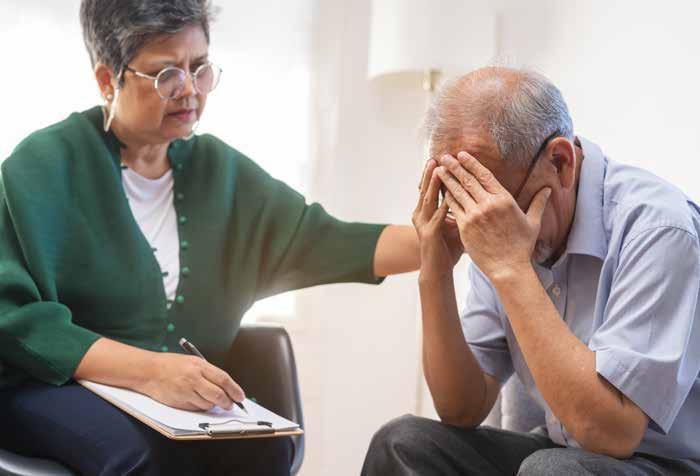
Don’t overlook the symptoms
Mental
deterioration is not always a result of growing old.
No matter
your
age, when the going gets tough, seek help and get treated.
by Vicki Yang
They call it the golden years of one’s life but, for some seniors, these later years may be overshadowed by psychogeriatric conditions. Among these conditions, dementia and depression are oftenheard concerns that older adults struggle with. According to the Well-being of the Singapore Elderly (WiSE) nationwide study conducted in 2013, dementia strikes 1 in 10 Singaporeans aged 60 years and above while the prevalence rate for depression is 1 in 27.
A decade after the study, the silver lining on the horizon lies in the greater awareness of mental health issues among the public and their increased willingness to seek help. “The COVID-19 pandemic has raised overall mental health awareness across all age groups, and there were more community outreach programmes to reach out to the seniors,” said Clinical Assistant Professor Vanessa Mok, Senior Consultant, Department of Psychological Medicine, Changi General Hospital (CGH), and Project
Director of Community Psychogeriatric Programme (CPGP).
Yet, ensuring that seniors can get the help they need continues to be challenging. According to the National Population Health Survey 2022, Singapore residents aged 60 to 74 were the least willing to seek help among the age groups affected by poor mental health.
An ecosystem of care
The CPGP, which started in 2007, includes psychiatrists, psychologists, medical social workers, occupational therapists, physiotherapists, and other support staff. The multidisciplinary team’s comprehensive synergies enable them to address the gamut of health issues senior residents may face, alongside their mental health struggles. Patients may also be referred to the appropriate specialists or medical services when necessary, strengthening the ecosystem of care provided.
To reach out to more residents, CPGP conducts clinical home visits and partners community social and eldercare agencies. Training is provided to these agencies so that they can offer mental health screenings and support to senior residents, thus aiding in early detection.
Going beneath the surface
Early-detection efforts are particularly crucial as it can be challenging to identify signs of a precarious mental state in seniors. After all, a condition like depression can present in various ways.
“The signs are not necessarily sadness, hopelessness, or not wanting to live. Sometimes it can come across as a physical ailment,” explained Clin Asst Prof Mok, citing examples such as giddiness, headaches, heightened irritability, or a marked change in temperament. “The changes can be very subtle, and it is important for someone close to them to identify these changes. As symptoms are different in seniors, it is important to seek help early,” she stressed.

Clin Asst Prof Mok leads the community mental health team at CGH to provide tailored mental health care for senior residents in the Northeast and Southeast regions of Singapore. She focuses on those who are unable or unwilling to access outpatient services at healthcare institutions. This inability could be due to mobility issues, concerns related to the stigma of mental health treatment, or a refusal to see a doctor. It was observed that some of these residents have not visited a doctor in decades.
"The signs are not necessarily sadness, hopelessness, or not wanting to live. Sometimes it can come across as a physical ailment,” says Clin Asst Prof Vanessa Mok on the symptoms of mental health struggles among seniors.
One cautionary point that a caregiver can note and monitor is when significant changes occur in an older person’s life.
“For example, loss — of independence, relationships, or health — could be a trigger. It could even be a recent surgery such as knee replacement or a cataract operation; it does not necessarily need to be a major one,” shared Clin Asst Prof Mok. “Any sort of change is a point where we need to pay more attention to how they are coping, whether they need more help, and if they need to connect with a healthcare provider for appropriate assessments.”
A misconception that she would like to dispel is the conventional ideas about growing older that have been inculcated in us over the years. “One of the biggest misconceptions is that these struggles happen to everybody as they grow older — that’s not true. It’s never too early or too much to ask if something is wrong. What is most important is to start asking, so that concerns are identified early and there can be effective and timely treatment,” she said.
14 HealthWatch
Sun and heat tend to trigger eczema, itchy skin
Eczema may come in many forms but they tend to cause itching and inflammation.
by Candice Lee and Felicia Ong
Rash on the eyelids. Cracked, scaly, weeping skin. Itchy fingers. These are all forms of eczema, the common itchy skin condition that can flare up on exposure to anything — from the weather to the environment.
The skin condition affects people at any age. While it cannot be cured, its symptoms — often itchiness and dryness — can be eased with creams, medications and avoiding the so-called triggers.
Heat and hot weather are well-known triggers. “Eczema is definitely one of the big conditions I see in clinic. With the recent hot spell, we’ve had tons of patients coming in for their eczema flaring,” said Dr Shashendra Aponso, Associate Consultant, Department of Dermatology, Singapore General Hospital (SGH). “There are so many different types of eczema.”
Atopic dermatitis or atopic eczema is typically associated with allergy, tending to afflict people with a sensitive nose, asthma or allergic rhinitis. Said Dr Shashendra: “It can very commonly present when you are young. So you’ll see kids with rashes on their neck and on their skin folds, such as behind their knees. Some outgrow this but, for others, the condition can continue into adulthood.”
At the other end of the age spectrum is asteatotic eczema, which is related to old age. “Elderly patients often get red, itchy and scaly skin on their arms and legs. This is dry skin-related and, sometimes, it can also be a bit weepy,” he said. Associated with older people too is stasis eczema, which develops in those with poor blood flow. They tend to have varicose veins with rash appearing around them. They also display leg swelling, usually in the lower part, and brown pigmentation. “They sometimes look like they are wearing stockings,” said Dr Shashendra.
Stasis eczema can be treated by dealing with the underlying causes — poor blood flow and varicose veins. For the other forms of eczema, avoiding the triggers — heat, dust, dryness, allergens — and using medications like mild steroid cream and antihistamines and moisturising creams usually help keep the eczema symptoms at bay. This is particularly true of contact dermatitis or contact eczema, where the skin comes into contact or is exposed to everyday products,

from household cleaners and hand sanitisers to cosmetics and jewellery.
Dr Shashendra cited the case of a patient who had rash on her eyelids but had not used any new cosmetics. The culprit was later found to be her new manicure, a gel acrylic. The acrylate had leeched onto the thin skin around the eyes when she was putting makeup on.
More commonly, people who do housework can get irritant eczema from using household detergents, floor cleaners, and the like. “The substance irritates the skin and causes inflammation. So they might get little blisters that look like dots on the sides of the fingers, and even the nails,” said Dr Shashendra. Wearing gloves, reducing the washing, and applying a prescribed mild steroid cream can help bring down the inflammation. Still, one of the biggest culprits in Singapore is the sun and the heat. “Heat is bad enough, but sweating can worsen eczema. Sweat is an irritant, and it often collects in the folds of the skin, making the skin itch even more than just the heat,” said Dr Shashendra. Wearing tight-fitting gym clothes can trap heat, aggravating eczema symptoms. Bed-bound elderly patients can also suffer from eczema and heat rash
because they are lying in bed for long periods of time. “We see it on their back as there’s not a lot of ventilation there. So immediately you change those factors — get them cool, wear breathable fabric, use ice packs sometimes — to help them,” said Dr Shashendra.
"Sweat is an irritant, and it often collects in the folds of the skin, making the skin itch even more than just the heat,” says Dr Shashendra Aponso about the two biggest triggers for eczema in Singapore.

While it is tempting to shower often, Dr Shashendra warns against damaging the skin’s natural oil protective barrier. “It’s like washing an oily plate. Using hot water strips the oil from the plate,” he said, adding that keeping to just 15 minutes a day — regardless of the number of showers — is ideal.

To find out more about heat and its effects on the skin, scan the QR code to listen to the ‘Hot & Humid — Itching to know more about skin irritation’ episode of SGH’s Perfectly Imperfectly Health podcast.

15 HealthWatch
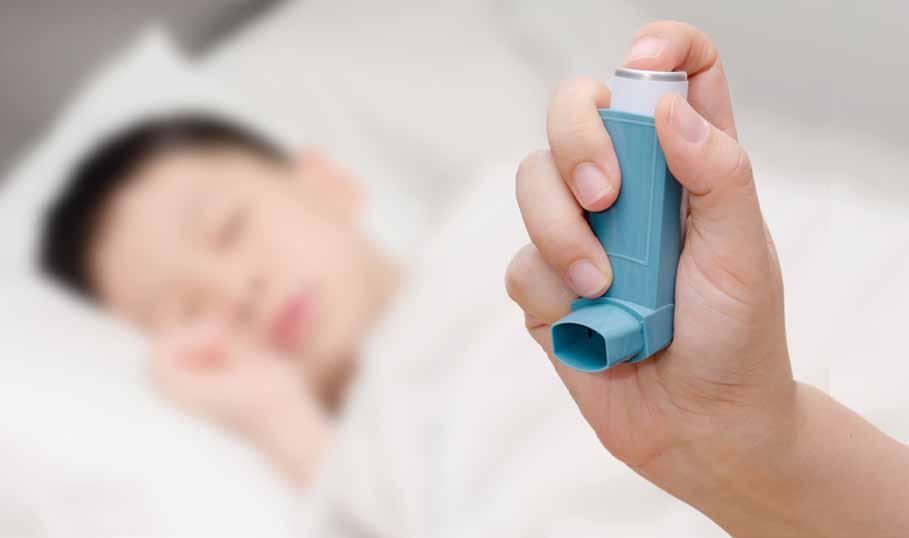
Breathe easy
Delve into the facts and challenges of managing asthma.
by Dr Jessica Tan, Head and Senior Consultant, Department of Respiratory Medicine, Sengkang General Hospital
What is asthma?
Asthma is a chronic inflammatory condition that causes narrowing of the airways (bronchoconstriction) and increased airway mucus production.
Who is more susceptible to asthma?
Anyone can develop asthma. However, individuals who have a family history of asthma and those with allergic (atopic) tendencies such as allergic rhinitis and eczema are more susceptible. The Ministry of Health’s (MOH) National Population Health Survey reported a lifetime prevalence of 10.5 per cent, with a prevalence of 4 per cent in adults aged 18–69.
Treatment methods and common medication
The primary treatment is inhaled corticosteroids (ICS), commonly referred to as ‘inhaled steroids’, which reduces airway inflammation and symptoms like cough, breathlessness and phlegm production, as well as reducing the frequency of asthma exacerbations. They are considered the most effective long-term medication for controlling and managing asthma. When used daily, ICS decrease the frequency and severity of asthma attacks. However, they will not relieve an asthma attack that has already started. In such cases, short-acting beta-agonist (SABA) such as
What are the symptoms?
chronic cough (especially night cough) lasting more than eight weeks
symptoms have fluctuations that occur during each day where it gets worse at night and in the early morning, also known as diurnal variation
intermittent symptoms (may not be daily), with episodic worsening that may require an increase in medication
While Ventolin is a common medication used to manage asthma, it should never be used as the only treatment for patients with asthma.



Products shown are for illustration purposes only and do not imply endorsement or sponsorship.
salbutamol (Ventolin) will be required for faster relief of bronchospasm.
However, it is important to note that SABA offers temporary bronchodilatory effects, with no impact on airway inflammation. Research has shown that asthmatic patients who use Ventolin alone for treatment of their asthma have a higher risk of suffering a life-threatening asthma attack and higher risk of death.
If symptoms of asthma remain uncontrolled with ICS, doctors may consider combining this medication with a long-acting betaagonist (LABA), also referred to as a LABA-ICS combination. LABAs are inhaled medications that work by relaxing the muscles around the airways, opening up the airways of the lungs for up to 12 hours. They can also help control symptoms at night or during periods of exercise. They are not intended to be used on their own for the treatment of asthma, and are always used alongside ICS.
In severe cases of asthma, additional treatments may include long-acting muscarinic antagonists (LAMAs) to aid long-term asthma control, oral corticosteroids, and biologics, which can help slow or stop inflammation.
16 AtAGlance
wheezing shortness of breath chest tightness
SABA LABA-ICS LAMA





Q uestion & A nswer
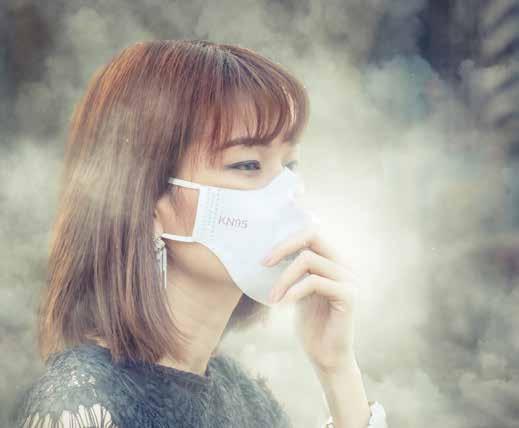
Are N95 masks necessary when haze strikes?
I am pregnant and worry about the haze as the weather turns hotter and drier in the coming months. Should I wear an N95 mask outdoors? There are young children and seniors in my household.
Short-term exposure to the haze may lead to nose, throat or eye irritation, which should abate or resolve with rest (indoors) and minimising time spent outdoors.
Generally, symptoms develop one to three days after exposure to the haze. Higher levels or prolonged exposure to the haze can lead to symptoms of bronchitis, which resemble an asthma attack — wheezing, cough, chest discomfort, and shortness of breath. If the symptoms are severe, you should consult a doctor immediately.
People considered vulnerable may develop symptoms at lower levels of exposure to the haze. The most vulnerable group — those with chronic heart and lung disease such as asthma or chronic obstructive pulmonary disease — should avoid outdoor activity when the 24-hour Pollutant Standards Index (24H PSI) is in the ‘very unhealthy’ range (201–300). Children, seniors and pregnant women form the next vulnerable group; they should avoid outdoor activity when the 24H PSI is in the ‘hazardous’ range (over 300).
N95 masks may be helpful for vulnerable people or for healthy adults who experience prolonged outdoor exposure to the haze. It is important for the wearer to ensure that the mask fits properly, and is worn consistently. It is not necessary to wear the N95 mask indoors. They are not needed for healthy and fit adults who experience short exposure to the haze, like walking from the bus stop to the shopping mall.
Air pollutants from the haze include fine particles that are 2.5 microns or smaller (PM2.5). N95 masks provide good protection from inhaling this pollutant as they are certified to be 95 per cent efficient against fine particles of 0.1–0.3 microns in size.
It is important to keep the home environment clean and dust-free. Besides cleaning surfaces and mopping floors regularly, minimising activities that produce indoor air pollutants like smoking is also important.
Dr Chew Si Yuan Consultant, Department of Respiratory and Critical Care Medicine, Singapore General Hospital
When should I start on cholesterol-lowering medication?
My low-density lipoprotein-cholesterol (LDL-C) level is 3.6; my high-density lipoprotein-cholesterol (HDL-C) level is 4.3. Which reading should I pay attention to as there are different advice I’ve received on whether I should start taking medication. I don’t have other health issues. At which point should I start on medication for high cholesterol?
The decision to initiate cholesterol-lowering medication depends on your lipid profile and overall cardiovascular risk. This risk can be determined by looking at the patient’s medical conditions such as diabetes and coronary heart disease. In patients with no medical conditions, calculating the 10-year cardiovascular risk using the Singapore-modified Framingham Score will help stratify them into low, borderline, intermediate or high risk.
The ideal LDL-C target for low- and borderline-risk patients is less than 3.4mmol/L. For patients in these risk groups with suboptimal LDL-C values, a healthy diet and regular physical activity are still the first-line treatment. If lifestyle modifications are not able to sufficiently control the cholesterol levels, the decision to initiate medication will then be discussed.
Based on your lipid profile, it sounds like you are likely in either the low- to borderline-risk group. You can consider modifying your lifestyle and repeat your lipid panel in three to six months to assess for any improvement in LDL-C levels. Do also consult your physician to ascertain your target cholesterol levels based on your 10-year cardiovascular risk, as he/she will consider the above factors in his/her clinical assessment and manage accordingly.
Dr
Pamela Gopal Associate Consultant, Post-Acute and Continuing Care Department, Sengkang Community Hospital
18 AskOurExpert
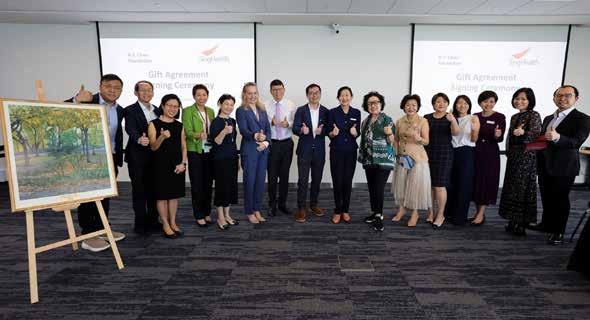
that Singapore citizens and residents can register their particulars online and skip the queue at registration counters when visiting their loved ones at Singapore General Hospital (SGH) wards? Doing so allows for a more convenient and hassle-free visit. It also allows the hospital to manage the number of visitors to the wards, and facilitates contact tracing for the safety of patients and visitors when the need arises. Multiple visitors may register for the same patient but only two visitors can enter to visit the patient at any one time, subject to the hospital’s prevailing Visitor Policy. For visitors to the wards, they must
that the H. S. Chau Foundation has made its inaugural $1 million gift to SingHealth to support financially vulnerable women in need of advanced cancer treatments, like proton therapy and immunotherapy? With over 84,000 new cancer cases reported in Singapore between 2017 and 2021, and projections indicating a doubling of cases by 2030, especially among women, this contribution is meaningful.
The top three cancers affecting women in Singapore are breast cancer, colorectal cancer, and lung cancer. The foundation’s commitment exemplifies impactful giving for the advancement of women in society. Some women with complex cancer conditions forgo recommended treatment in order not to impose a financial burden on their families. We are grateful to H. S. Chau Foundation for this transformational gift, which will provide much-needed support for financially vulnerable patients. Find out more about making a gift to advance research, innovation and education: https://www.singhealth.com.sg/giving








19 DidYouKnow
Ngee Ann Academy www naa edu sg The course is not accredited by the Singapore Nursing Board (SNB) and does not lead to certification as an Advanced Practice Nurse (APN) Fully delivered and awarded by King's College London Flexible and adaptive framework 24-month, part-time master's programme in Singapore Ranked #2 in the World and #1 in the UK for Nursing (QS World University Rankings by Subject 2024)
your Nursing career with KING'S MASTER OF SCIENCE IN CLINICAL NURSING Specially designed for SNB registered nurses, shape your nursing career at King's College London with the Bachelor of Science in Nursing with Honours (Top-up) and the Master of Science in Clinical Nursing. Start your journey as a King's Nurse today! Scan QR code to apply! SNB Accredited Nursing Degree Graduate with direct Honours 24-month, part-time degree programme in Singapore BACHELOR OF SCIENCE IN NURSING WITH HONOURS (TOP-UP) Ngee Ann Academy Pte Ltd 391A Orchard Road #25-02A Ngee Ann City Tower A Singapore 238873
Shape
PHOTO: VERNON WONG

